Hi. I'm practising profitability cases, and getting stuck on how to write an issue tree that combines 1. the typical financial analysis (Profits = Revenue*Costs), and 2. the more qualitative analysis (external + market trends, customer preference, competitor dynamics, channel dynamics etc.) that may be driving a profitability issue.
How do you write a profitability issue tree that covers all such areas in a MECE way?
I'm having real problems with this. Any advice much appreciated.















